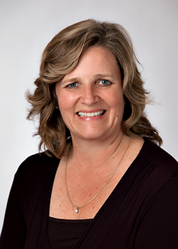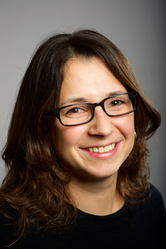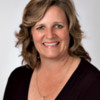Karissa Luckett at Clinica de la Raza, Oakland, California (Photo/Laurie Udesky)
______________________________________________
When the question of screening patients for adverse childhood experiences (ACEs) was first raised a couple of years ago, Santa Barbara pediatrician Andria Ruth had mixed feelings about it.

“We know our patients have a lot of these [ACEs] experiences,” said Ruth, who works for the Santa Barbara Neighborhood Clinics (SBNC), a network of four medical clinics, two dental clinics and one integrated health clinic in Santa Barbara County, CA, that receive federal funds and serve low-income families. “What if we screen them and we don’t have a plan for what we do after we screen them? Could we make things worse?”
While Ruth was ambivalent about ACEs screening initially, she soon overcame her concerns. She reports that screening parents and their babies for ACEs has opened up communication with her patients in unexpected ways. She recalls one mom who took her time during the screening. It ended up that her ACE score was 10, which meant she had been exposed to so many types of toxic stress that she was at high risk for chronic illness and mental problems.
“It was touching to me that she said, ‘Dr. Ruth, I’m filling this out and giving it to you and I feel good about it now,’” Ruth says. “’I’m in a different place then I was then, and I want better things for my kids.’”
Ruth’s initial worries are a common concern among health care providers, according to Karissa Luckett, a registered nurse and social worker who serves as a consultant for the National Pediatric Practice Community on ACEs (NPPC). The group provides training and coaching to six pilot sites around the country, including SBNC, in how to implement ACEs screening. It also encourages physicians interested in implementing ACEs screening to become members of NPPC and share resources.

The NPPC, launched in May 2017, is a project of the Center for Youth Wellness CYW), founded by trailblazing pediatrician Dr. Nadine Burke Harris, who is on a mission to push for universal ACE screening and help for families to prevent the long-term health outcomes of ACEs. NPPC’s website calls clinicians to action, asking them to join NPPC in “ending a public health crisis that is hiding in plain sight.” In three years, NPPC hopes to have 1,000 clinicians screening 300,000 children for ACEs. Burke Harris details the roots of this quest in her book The Deepest Well and in a TED talkshe gave in 2014.

The NPPC was created as a result of the widespread attention Burke Harris was getting for her work, according to NPPC Director of Strategic Initiatives Sara Marques. As Burke Harris writes in The Deepest Well, she had transformed her clinic in San Francisco’s Bay View Hunters Point neighborhood, an area where, “poverty, violence, substance abuse and crime have created a multigenerational legacy of ill health and frustration,” into a place where each child and family was examined through a lens of how ACEs and toxic stress contributed to their health problems. And they were offered an ever-growing menu of services to build their resilience, be it parent-child therapy, mindfulness meditation, bicycle giveaways or yoga classes.
ACEs comes from the landmark Centers for Disease Control and Kaiser Permanente Adverse Childhood Experiences Study that linked 10 types of childhood traumas, such as being hungry on a regular basis, witnessing a parent being abused, or being separated from a parent because of divorce or incarceration, to adult onset of chronic disease, mental illness, violence and being a victim of violence. In the last 20 years since the publication of the study, subsequent ACE studies have added racism, bullying, and witnessing violence outside the home, in addition to other types of childhood adversity. Also, during that time, a growing body of research about ACEs science has emerged that includes how ACEs affect brain development, epigenetics, and how resilience can heal the long-term health effects of ACEs.
Luckett says that Ruth’s initial concerns about ACEs screenings were valid. But, she says, “I think it’s a double-edged sword. We’re not going to know what resources we need until we start ACEs screening and see what we need.” Typically, explains Luckett, “after three or four months of screening we find we don’t just need a social worker, we need help with food insecurity, or healthy eating, or mindfulness, or how to be resilient.”
That approach of jumping in and figuring it out is part of the mindset of the NPPC, which describes itself as a “codesigned community.” “We’re a clearinghouse,” says Marques.
NPPC has provided its pilot sites with staff training and helps with everything from developing workflow around ACEs screening and scripts for its staff to use with patients, to screening tools and help with coding and capturing visits in its electronic health records.
The SNBC’s Goleta location, in fact, has screened 64 parents and their infants and toddlers for ACEs since October 2017. It was the second of six pilot sites of the NPPC to begin the screening.
There were a number of turning points for the SBNC’s Ruth that made the screenings more comfortable: One was making connections with pediatricians who had begun screening for ACEs at CYW’s 2016 ACEs conference. SBNC had already decided to develop an ACEs screening protocol, she said, as part of the Santa Barbara Resiliency Project, a local collaborative of representatives from health care, social services, education and community organizations and other sectors, (The project also has a community group on ACEs Connection.)
Other turning points for Ruth were SBNC partnering with a local community organization called CALM (Child Abuse Listening Mediation), which provides therapy to families with younger children, and partners with Drs. Mariam Kiya- Keating and Miya Barnett of UC Santa Barbara’s Department of Psychology. They helped develop the design of the clinics’ study.
With input from its partners, SBNC decided to screen parents and infants and up to three years of age, instead of the initial plan to screen infants and up to age 5. The reason for screening parents, according to SBNC Chief Operating Officer Nancy Tillie, was abundantly clear: “If the parents would be responding on behalf of their infant and then respond based on their own ACEs, we could figure out the risk for the child based on their parents’ ACEs.”
A new body of research is making preliminary inroads in linking parents’ ACE scores and developmental problems in their young children. A recent studyin the American Journal of Preventive Medicine that surveyed 1,293 mothers found that parents who had an ACE score between 1 and 3 were 1.86 times more likely to report a developmental concern with their child than parents with an ACE score of 0.
The decision to screen younger children was in response to a local project on school readiness that wasn’t getting the results it hoped for, according to Tillie.
When the J.S. Bauer Foundation, which funded the project, “went back and asked what are we missing, what are we not doing,” recalls Tillie., the sense was [clinicians] had to get involved with the family beforepreschool. There needed to be an intervention before that.”
Another pressing concern for Tillie to make their model sustainable was trying to figure out how services they provide around ACEs screening and resilience building might eventually be reimbursable. As such, Tillie met with Santa Barbara’s local managed care representatives, and formulated outcome measures for their study based on the agency’s suggestions. Those include gathering data to determine if the patients in their study have fewer visits to the emergency room, higher immunization rates and changes in their weight.
 NPPC visited and trained all 168 members of the SBNC network in January 2018. Significantly, the training occurred just a month after the Thomas fire and mudslides had struck the area killing 22 people, destroying homes and causing trauma in the entire community.
NPPC visited and trained all 168 members of the SBNC network in January 2018. Significantly, the training occurred just a month after the Thomas fire and mudslides had struck the area killing 22 people, destroying homes and causing trauma in the entire community.
“The NPPC team arrived and were so very compassionate in the recognition of what our community and staff were experiencing as a result of these conditions,” said Tillie. “This helped us to amend the ACEs questionnaire to incorporate questions regarding experiencing natural disasters, naming some of these just experienced, and the fear of injury and loss of life of a loved one.”
SBNC’s protocol is set up so that parents with ACE scores of 2 or more, or their infants with scores of 1 or more, are randomized into one of three groups. One group only sees a wellness navigator at SBNC who assesses the basic needs of a family — including food, housing, transportation, or other basics — and links them to community-based services. A second group of parents sees the wellness navigator and receives four therapy sessions at the clinic. The third group receives four therapy visits at the clinic and an additional four home-based therapy sessions. All therapy sessions are with a CALM therapist.
“The entire idea around the study is to try to determine the dose of intervention that makes a difference,” said Tillie. That is, does it make enough of a difference to get help from a wellness navigator or are therapy sessions necessary and how many make a difference?
Daisy Capristo is a therapist with CALM. In the sessions she’s had with parents in the SBNC pilot thus far, some have said pointedly that they want to use a different roadmap for raising their children than their parents used.
“One mother told me that she didn’t want to be the same as her mother. She said, ‘I’m not going to spank my children.’” But the mother clearly needed guidance; she didn’t know how to deal with her anger. Capristo taught her how to stop and breathe when her daughter’s behavior agitated her. She also tutored the mother in aspects of child development. For example, says Capristo, she explained to the mother that when her baby was pulling out things from cabinets, it was not a sign of disobedience, but a normal part of child development – her baby was learning by exploring the world around her.
She also showed her how to distract her baby with a toy if she wanted her to stop doing something instead of raising her voice.
The SBNC will expand its ACEs screening to its three other medical clinics by the end of 2018. Data from it and the other five NPPC pilot sites is expected to be available in six months.
_____________________________________________________________________
For more information about the NPPC on ACEs, contact NPPC Program Director Leena Singh at: lsingh@centerforyouthwellness.org, or visit its website at: https://nppcaces.org





Comments (0)